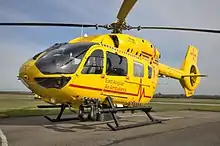Flight paramedic
A flight paramedic is a highly trained paramedic that provides care to sick and injured patients in an aeromedical environment on either fixed or rotor wing aircraft. Typically a flight paramedic will work with a registered nurse, physician, Respiratory Therapist, or another paramedic.[1] Flight paramedics must have an advanced level of medical knowledge along with years of clinical experience in a high acuity environment. Flight paramedics in the United States usually hold certifications such as the FP-C or the CCP-C, while in countries like the United Kingdom, they will usually be required to hold a postgraduate certificate in critical care as a minimum, with many holding a master's degree in advanced practice or aeromedical critical care.[2][3]
Education and training

Within the US, the minimum requirements for most flight paramedics include:
- Licensed as a paramedic by a state EMS board
- 3-5 years as the lead paramedic in a high call volume EMS ground service
- Advanced Cardiovascular Life Support, Pediatric Advanced Life Support, Pre-Hospital Trauma Life Support or ITLS
Additional requirements may include:
- Neonatal Resuscitation Program
- Certifications such as the FP-C or CCP-C (usually required within 2 years of commencing employment in the United States)
- Critical care classes such as the CCEMTP by UMBC.
- A postgraduate certificate or master's degree (in the United Kingdom or the Commonwealth)
Roles and responsibilities
The roles and responsibilities will vary by organisation and country. Typical responsibilities will include:
- Perform as a member of an aeromedical evacuation team on rotor and/or fixed wing aircraft
- Plan and prepare for aeromedical evacuation missions
- Provide in-flight critical care to patients[4]
- Care for patients with both medical and traumatic issues
- Possess advanced understanding of mechanical ventilation, hemodynamic support, vasoactive medications and intensive care skills[5]
- Possess specialized clinical skills in union with knowledge, theory, education and expertise in hospital and pre-hospital environments
- Ability to perform advanced medical procedures without supervision of a doctor such as rapid sequence intubation, ventilator management, finger thoracostomy/chest tube insertion, central line placement, intra-aortic balloon pump management, pericardiocentesis, titration of vasoactive medications, administration of general anesthetics and paralytics for intubation, as well as sedatives and analgesic medications for pain and anxiety.[6]
See also
- Aircrew (Flight crew)
- Air medical services
- Certified Flight Paramedic
- Combat medic
- Medic
- Museum of Aerospace Medicine
- Royal Flying Doctor Service of Australia
- Enlisted Medics (U.S. Air Force)
- Flight Paramedic certification or FP-C
References
- Ron Walls MD; John J. Ratey MD; Robert I. Simon MD (2009). Rosen's Emergency Medicine: Expert Consult Premium Edition - Enhanced Online Features and Print (Rosen's Emergency Medicine: Concepts & Clinical Practice (2v.)). St. Louis: Mosby. pp. 2469–75. ISBN 978-0-323-05472-0.
- "Join Our Medical Crew – Clinician Recruitment". The Air Ambulance Service. Retrieved 2021-04-12.
- "Advanced HEMS Practice". Bangor University. Retrieved 2021-04-12.
- Surgeons (AAOS), American Academy of Orthopaedic; Physicians (ACEP), American College of Emergency; UMBC (2017-03-20). Critical Care Transport. Jones & Bartlett Learning. ISBN 978-1-284-04099-9.
- Faudree, Kyle (2011-11-11). Flight Paramedic Certification: A Comprehensive Study Guide. Immediate Action Medicine, LLC. ISBN 978-0-615-56313-8.
- "Wisconsin Critical Care Transport Paramedic Curriculum" (PDF).
{{cite web}}: CS1 maint: url-status (link)